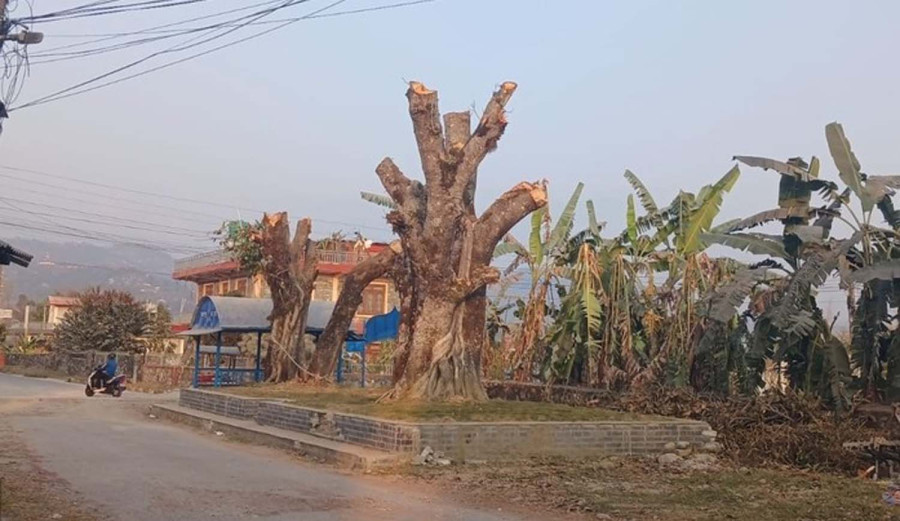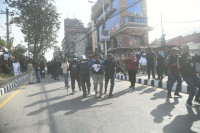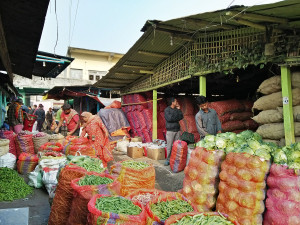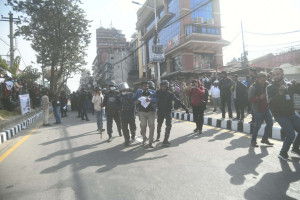Editorial
Save the trees
Continued destruction of our precious natural resources could invite an environmental ruin.
Humans have little regard for the environment that sustains them. Take the case of trees, which have been around for millions of years. Our focus on infrastructure development has not only led to the destruction of trees but also the habitats of countless birds and animals. A recent instance of this foolhardiness can be seen in Pokhara Metropolitan City, wherein many old trees, including the sacred ones—banyan, peepal, mango and others—have been cut in different wards in preparation for ‘Kotihom Birat Mahayagya’. The event is reportedly being held in April by the Manav Sewa Foundation—the same organisation which conducted Kotihom in Pashupati last year. The city office seized 50 trucks of wood on Wednesday.
What’s concerning is that the trees have been cut in a way that reduces their regrowth—even the branches that needed no pruning have been chopped off. Ecologists say the trees were home to many birds, and with springtime being a prime breeding season, the destruction wreaked without following scientific process is bound to destabilise the local ecosystem.
This reminds us of a 2022 incident that garnered the attention of ecologists and conservationists alike. While expanding the Mugling-Pokhara section of the Prithivi Highway, a kapok tree that was home to a slender-billed vulture—an endangered bird species—was felled despite desperate calls requesting the Department of Roads and the construction company to halt the process until the egg was hatched.
Such instances are but representatives of a much bigger problem. A few years ago, over 2,000 trees along the 8.2 km Kalanki-Balaju-Maharajgunj road section were felled as part of the Kathmandu Ring Road Improvement Project. Because of this, the city turned into a concrete jungle, even as several species of birds declined. Around 7,000 trees met with the same fate while expanding the Prithivi Highway, leading to the loss of habitat of many birds and animals. Concomitantly, as more than 12,000 trees have been chopped along the Kakarbhitta-Laukahi section of the East-West Highway since last February, habitats of many endangered reptiles and birds are being wiped out. Such cases are rampant across the country but often go unnoticed.
Our authorities were adamant on cutting down 2.4 million small and large trees to build the Nijgadh International Airport in Bara district, which would have badly damaged the environment, biodiversity, local community and wildlife. Thankfully, the Supreme Court quashed the bid in May 2022, taking a cue from environmentalists. The environmental impact assessment and initial environmental examination are mandatory under the Environment Protection Act 2019 when clearing more than five hectares of forest area. However, even the projects carried out by the government often don’t adhere to the EIA needs. Fallen trees often outnumber the approved limits, leading to massive deforestation and loss of wildlife. Moreover, even as there is a legal provision for compensating afforestation for the trees felled, the provision is seldom implemented.
Human needs and development activities should never come at the cost of the environment or the survival of other species. If we continue to prioritise short-term gains over long-term sustainability, the consequences will be grave. It is thus high time to adopt sustainable development practices, like assessing the environmental damage before cutting down the trees, conducting mass afforestation campaigns and punishing those who flout the rules. In the case of Pokhara, as per news reports, the local level responsible for protecting the trees and species inhabiting them is also involved in the misdeed. All this suggests we need to put more thought into how we can harmoniously coexist and fit into the larger ecosystem before our precious flora and fauna are forever lost.




 7.12°C Kathmandu
7.12°C Kathmandu












%20(1).jpg&w=300&height=200)

